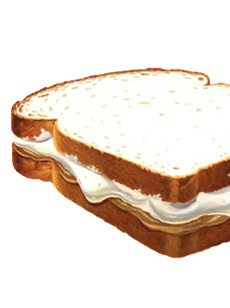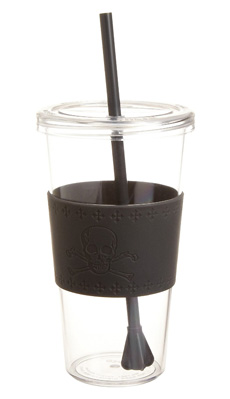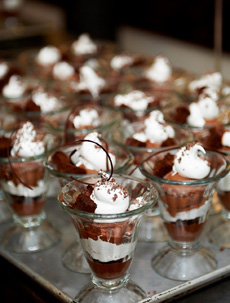|
Fluffernutter sandwiches require bread plus two fillings: peanut butter and marshmallow creme. Peanut butter was invented in 1890 but not mainstreamed in America until 1908 (see the history of peanut butter).
Marshmallow, on the other hand, dates back to ancient Egypt, and marshmallow sauces were popular in the early 20th century (see marshmallow history). A marshmallow creme called Marshmallow Fluff was sold to ice cream parlors in 1910 by the Limpert Brothers, and Snowflake Marshmallow Creme was available around 1914. The first commercially successful, shelf-stable marshmallow creme, it was produced by the Curtis Marshmallow Factory of Melrose, Massachusetts.
Marshmallow Fluff wasn’t the first marshmallow creme, but it’s the one that endured: 94 years later, the brand is still around. No one remembers the Limperts or the Curtises.
|
|

A basic Fluffernutter sandwich. Photo
courtesy Durkee-Mower. |
Made of corn syrup, sugar, dried egg whites and vanilla flavoring, Marshmallow Fluff’s origin dates to 1917. A Somerville, Massachusetts man named Archibald Query made a proprietary recipe in his home kitchen and sold it door-to-door.
In the middle of World War I (1914 to 1918), sugar shortages forced Query to move on to other work. When peace returned, he was content with his situation and sold the formula for $500 to two returning veterans, H. Alan Durkee and Fred L. Mower. The product was popular among local homemakers, and the door-to-door sales soon shifted to grocers’ shelves. The rest is history.
But what about the Fluffernutter sandwich?
There’s no specific reference that cites when and where the Fluffernutter was born. We know who created the first sandwich filled with peanut butter and marshmallow creme, but not who named it. Was it someone at Durkee-Mower who sought to publicize the name, a creative consumer whose recipe was published in the local paper or perhaps a sandwich sold at a luncheonette? Durkee-Mower records don’t say.
Who Made The First Sandwich With Peanut Butter & Marshmallow Creme
Emma Curtis, co-owner with her brother of the Curtis Marshmallow Factory, was prolific in the development of many recipes for Snowflake Marshmallow Creme. Some of the first product labels, dating to 1913, suggested using the creme in sandwiches, topped with chopped nuts.
In a recipe leaflet published in 1914, Emma suggests peanut butter as an accompaniment to the marshmallow creme. She thus gets the credit as the person most likely to have created what later became known as the Fluffernutter sandwich. Other claimants, please step forward! (Source.)
In a booklet published before the end of the war, in 1918, Emma introduced the Liberty Sandwich: marshmallow creme and peanut butter (Americans were urged to give up meat one day a week during the war). The same recipe appears on a label for SMAC, an acronym for Snowflake Marshmallow Creme, which the brand adopted in 1922. (Source.)
By 1935, peanut butter and marshmallow creme were an established pairing. An ad for SMAC presented many uses including, “Make sandwiches for the kiddies with SMAC and peanut butter.” But then, no “SMACwich” soared into history. Instead, we have the Fluffernutter. Did someone at Durkee-Mower, in the Boston area along with Curtis, see the SMAC ads and snitch the recipe, renaming it the Fluffernutter? That’s our [totally unsubstantiated] guess.
Ways To Celebrate National Fluffernutter Day
Classic Fluffernutter Sandwich. The basic is creamy peanut butter and Marshmallow Fluff on white bread. We like to substitute whole wheat bread for the white bread, chunky peanut butter for added crunch and half of a sliced banana or caramelized banana slices. Others add a few strips of bacon. Peanut Butter & Co. suggests crumbled graham crackers.
Strawberry Fluffernutter. Use Strawberry Marshmallow Fluff or add strawberry jam and/or sliced fresh strawberries. (You heard it here first!)
Mock Fluffernutter Sandwich. Another NIBBLE creation: If you’ve got marshmallows but no marshmallow creme, slice them (or use miniature marshmallows) and lay them atop the peanut butter.
As of this writing, Marshmallow Fluff is also made in raspberry and strawberry versions.
Toasted Fluffernutter Sandwich. Still another NIBBLE recipe: Toss the sandwich under the broiler (open face) for a gooey, toasty effect, using either marshmallow creme or sliced or miniature marshmallows. You can buy toasted marshmallow creme from Solo.
Cookies, Cake, Muffins. Top peanut butter cookies, cakes, cupcakes or muffins with Marshmallow Fluff. Alternatives: Make PB and Fluff cookie sandwiches; use Fluff as the filling in a peanut butter cake; use a pastry bag to inject Fluff into a cupcake or muffin.
Milk Shake. Make a Fluffernutter Shake: Add two tablespoons of creamy peanut butter and two large spoonfuls of Marshmallow Fluff into a blender, along with a cup of milk. Blend 30 seconds or until smooth.
Toonie Moonie makes organic marshmallow creme and Bountiful Harvest makes sugar-free marshmallow creme.
There’s a website devoted to all things Marshmallow Fluff, including many recipes. Check it out!
|




